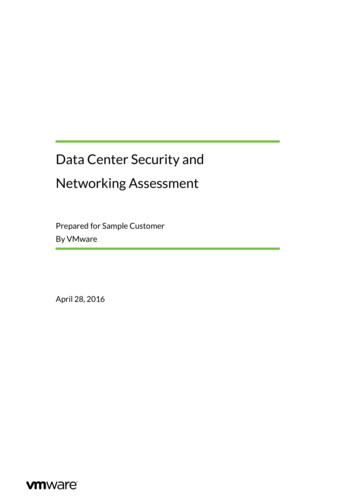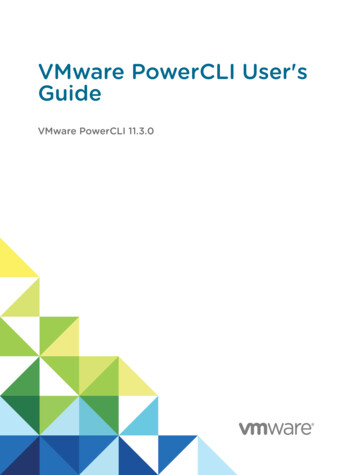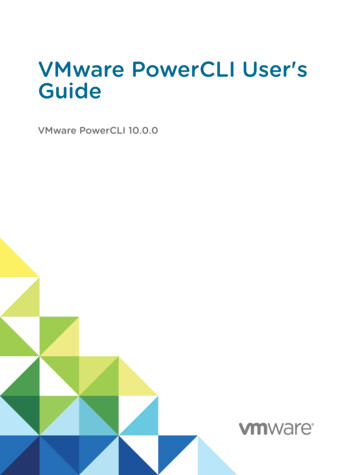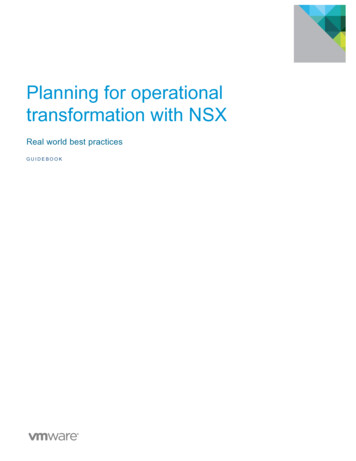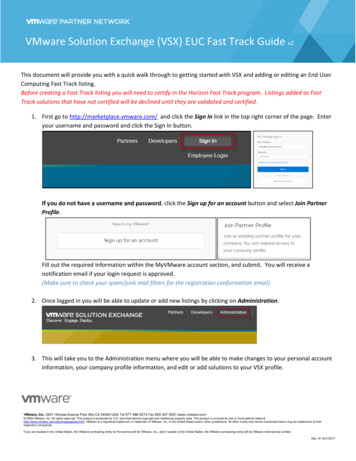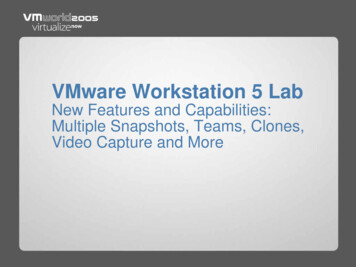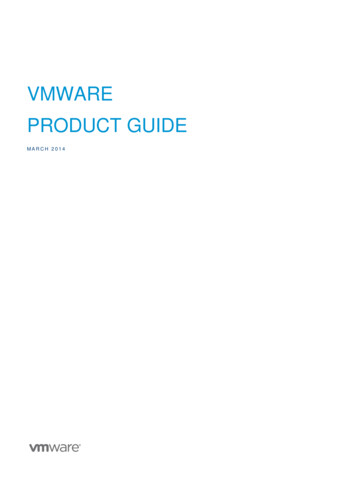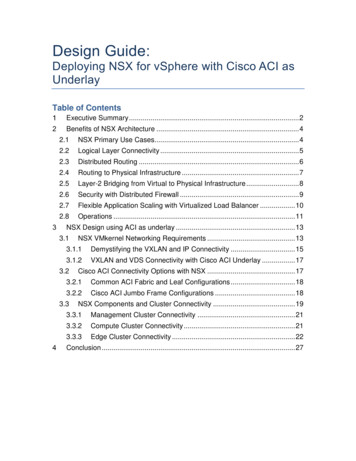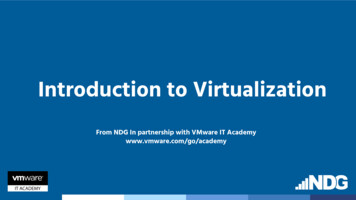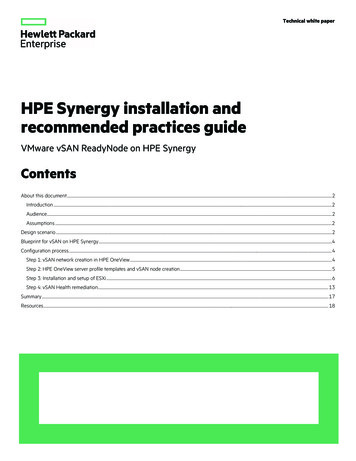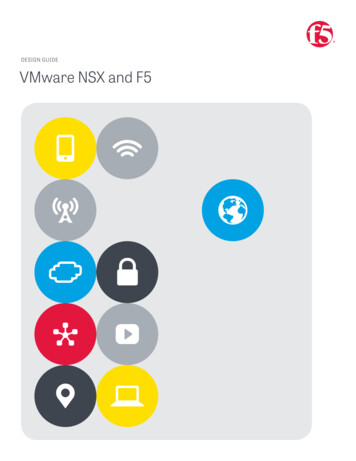
Transcription
DESIGN GUIDEVMware NSX and F5
DESIGN GUIDEVMware NSX and F5ContentsIntroduction3The Needs of the Business vs. IT Capabilities3The Software-Defined Data Center3F5’s Approach to Network Virtualization and SDDC4F5 BIG-IP Integration with VMware NSX6F5 BIG-IP and VMware NSX Use Cases12VMware NSX Overview14Network Planes15VMware NSX Architecture16F5 BIG-IP and VMware NSX20Integrating BIG-IP and VMware NSX23Deploying and Configuring an NSX-Managed BIG-IP VE28F5 BIG-IP/VMware NSX Configuration Topologies and Examples37Best Practices and Configuration Recommendations43Physical vs. Virtual Considerations62Alternative NSX-Aware Configurations62Conclusion65References65
DESIGN GUIDEVMware NSX and F5IntroductionThe purpose of this document is to provide a solution overview and design guidance forintegrating F5 Application Delivery Controllers (ADCs) with VMware NSX network virtualization.The content is intended for network architects currently using or planning to use networkvirtualization and ADC/load balancing services in their environment. This guide will focus onthe integration of F5 BIG-IQ Cloud and F5 BIG-IP virtual editions (VEs) with VMware NSXnetwork virtualization.The Needs of the Business vs.IT CapabilitiesOrganizations want to increase the speed of innovation, reduce time to market, and drive thevelocity of their businesses. Traditional IT architectures can be a barrier to these objectives. Theycan be costly to manage, and limited in configuration and scale. Legacy computing and IToperational models can be slow to respond to dynamic environments caused by shifting businessneeds or the rapid increase of users, devices, and applications. Furthermore, applicationarchitects and operations staff are experiencing difficultly orchestrating the lifecycle of applicationsand other IT services across the various silos of a typical IT organization. Society’s increasedreliance on business technology requires flexibility in how services are delivered and consumed.To be competitive while remaining efficient with resources, data center and IT operational agilitymust be all-encompassing. A change in IT processes and architectures can drastically reducelead times for deploying new applications and services, eliminate downtime due to unforeseenincreases in workloads, and speed disaster recovery. Solving this challenge requires collaborationacross all elements of the data center—including server infrastructure, networking andconnectivity, and the overall application delivery architecture.The Software-Defined Data CenterA software-defined data center (SDDC) architectural approach is required to meet many oftoday’s business expectations, helping organizations transform data center economics andincrease application deployment agility. The SDDC delivers elastic, “on-demand” IT infrastructureservices through the use of resource virtualization and abstraction of traditional computing,network, and storage assets.3
DESIGN GUIDEVMware NSX and F5VMware’s software-defined data center concept.VMware vSphere and its data center management suite of products provide a foundationalplatform for storage and compute in the SDDC. VMware NSX network virtualization extendsthe same benefits to the data center network to accelerate network service provisioning,simplify network operations, and improve network economics.VMware NSX decouples the logical networking from the physical infrastructure, removingmany of the operational and architectural barriers commonly seen with traditional networkinfrastructures and technology. Network virtualization with VMware NSX facilitates theautomation and management of the logical network and network services lifecycle.F5’s Approach to NetworkVirtualization and SDDCNetwork virtualization must be accompanied by changes in the provisioning of applicationdelivery services. The deployment of ADC functions must be based on data centerautomation and the adoption of cloud computing principles. Modern architectures and datacenter models require a more flexible approach to application services such as availability—one that better aligns with trends toward micro-services and API-based architectures.More broadly, given increased user mobility and an expanding “Internet of Things,” serviceproviders and organizations are reevaluating traditional architectural principles to determinehow best to move forward with application delivery service provisioning that can keep upwith, or at least catch up to, industry trends.4
DESIGN GUIDEVMware NSX and F5F5 Software-Defined Application Services (SDAS) is the next-generation model fordelivering application services. SDAS takes advantage of F5 innovations in scalabilitymodels, programmability, and an intrinsic decoupling of the data and control planes tocreate a unique application services fabric capable of extending the benefits of F5application delivery services to all applications, irrespective of location.F5’s Software-Defined Application Services framework.SDAS is the first fabric-based application delivery and control system. It enables serviceinjection, consumption, automation, and orchestration across a unified operating frameworkof pooled resources.F5 Software-Defined Application Services deliver: A fabric-based solution—F5 ScaleN technology powers an elastic, all-activeapplication service fabric that dramatically lowers the cost of delivering applicationservices by increasing utilization and service densities. Automation and orchestration—Intelligent service automation and orchestrationAPIs reduce operational expenses and fill a critical gap in SDDC and networkarchitectures. As a result, organizations with SDAS can streamline applicationdeployment and support continuous delivery. A unified operating framework—A rich, extensible catalog of application servicesempowers application owners to address performance, security, and availabilityconcerns in cloud, data center, service provider, and managed environments.The SDAS fabric provides a foundation for building elastic application services.5
DESIGN GUIDEVMware NSX and F5F5 BIG-IP Integration withVMware NSXThe integration between the F5 BIG-IP platform and VMware NSX extends VMware’sSDDC strategy to include F5 SDAS—delivering interconnected automation for network andapplication layer services. Customers can rapidly deploy applications and other relevantREFERENCE ARCHITECTURE: F5 Reference Architecture for VMware NSXCONTENTTYPE: ProductMap an agile environment that can reactIT services,creatingAUDIENCE: CIOswiftly to the demands of the business.AdminCloud Management& hird-PartyServerNSX ManagementiAppsApplication NSXvSwitchDeploying L3–L7 ServicesThe F5 and VMware NSX deployment scenario.The F5 BIG-IP platform and its full-proxy architecture complements the native networkvirtualization capabilities of VMware NSX by introducing the ability to enhance theintelligence, security, availability, and performance of mission-critical applications.A full proxy maintains two separate session tables—one on the client-side and one on theserver-side. There is effectively an “air gap” isolation layer between the two internal to theproxy—enabling focused profiles to be applied specifically to address issues and managetraffic peculiar to each “side” of the proxy.6
DESIGN GUIDEVMware NSX and F5Full-proxy architecture.Because all communication is funneled through virtualized applications and services at theapplication delivery tier, it serves as a strategic point of control at which delivery policiesaddressing traffic routing/intelligence and operational risk (performance, availability,security) can be enforced. Inserting an application delivery tier allows for an agile, flexiblearchitecture—more supportive of the rapid changes today’s IT organizations must deal with.7
DESIGN GUIDEVMware NSX and F5F5’s application delivery tier using full proxy.VMware NSX and BIG-IP virtual editions enable customers to build an adaptable, virtualizednetwork infrastructure that delivers the scale, consolidation, and business continuitydemanded by today’s advanced application infrastructures. BIG-IP VEs deliver the samemarket-leading SDAS that run on F5 purpose-built hardware.Combining the feature set of BIG-IP Local Traffic Manager (LTM) with VMware NSXincreases operational efficiency and ensures peak network performance by providing aflexible, high-performance application delivery system. With its application-centricperspective, BIG-IP LTM optimizes network infrastructure to deliver availability, security, andperformance for critical business applications.Key benefits of integrating BIG-IP LTM with VMware NSX include: Application traffic management and optimization—BIG IP LTM includes staticand dynamic load balancing to eliminate single points of failure. Application proxiesgive protocol awareness allowing for the control traffic for the most importantapplications.8
DESIGN GUIDEVMware NSX and F5Load balancing web servers with F5 BIG-IP LTM.BIG IP LTM also tracks the dynamic performance levels of servers in a group,ensuring that your applications are not just always on, but are easier to scale andmanage. BIG-IP LTM makes real-time protocol and traffic management decisionsbased on application and server conditions, extensive connection management, andTCP and content offloading. Out of the box security—The BIG-IP system provides better security by activelyterminating the flow of data. Traffic coming from the client can be examined beforeit is sent on its way to the application tier, ensuring that malicious traffic never passesthe proxy barrier. Traffic returning from the server can be fully examined before it isdeemed acceptable to pass back to the client, thereby ensuring that sensitive datasuch as credit card or social security numbers are never passed across the proxybarrier.PROJECT: GUIDE-BIGIQ-66263862-nsxFull Proxy licationFirewallHTTP iRuleHTTP iRuleSSL iRuleSSL iRuleTCP iRuleTCP iRuleAppsFull-proxy architecture.9
DESIGN GUIDEVMware NSX and F5The BIG-IP platform’s full-proxy architecture also provides an effective means tocombat modern attacks. Because of its ability to isolate applications, services, andeven infrastructure resources, this full-proxy application delivery tier improves anorganization’s capability to withstand the onslaught of a concerted attack. Secure application delivery—The BIG-IP system delivers industry-leading SSLoptimization, performance, and visibility for inbound and outbound traffic, so you cancost-effectively manage and protect your entire user experience by encryptingeverything from the client to the server. Intelligent application health monitoring—Intelligently monitor your applicationswith the BIG-IP system’s advanced application health monitoring capabilities. TheBIG-IP system includes a number of built-in monitor templates for specific monitoringof applications, which may be used as is or customized to meet your requirements.The BIG-IP platform’s application health and intelligent load balancing.BIG-IP LTM External Application Verification (EAV) monitors enhance applicationhealth monitoring by utilizing the BIG-IP system to perform complex and thoroughservice checks. They provide the ability to dive much deeper than merely performinga three-way handshake and neglecting the other layers of the application or service.EAV also brings added application intelligence by performing application-awaremonitoring, such as simulating an actual user login. This level of visibility into theapplication’s health provides a deeper insight on whether the application is trulyfunctioning as expected, rather than simply determining if a service is up/down or anetwork port is “listening.”10
DESIGN GUIDEVMware NSX and F5 Programmability—For advanced configurations and traffic management scenarios,the F5 iRules scripting language (F5’s traffic scripting interface) enablesprogrammatic analysis, manipulation, and detection of all aspects of the traffic inyour networks. Customers can implement security mitigation rules, support newprotocols, and fix application related errors in real time.Additional programmability options are available using iControl , F5’s open API thatallows complete, dynamic, and programmatic control of F5 configuration objects.With iControl, you can work like a wizard—adding, modifying, or configuring your F5device in real time. Wizard-driven configurations—The BIG-IP platform includes F5 iApps Templates,a powerful feature that enables you to deploy and manage enterprise applicationservices as a whole rather than individually managing configuration and objects.iApps gives you greater visibility into and control over application delivery—and helpsyou deploy in hours rather than weeks.iApps Templates are integrated with VMware NSX to provide an application-centricconfiguration approach, aligning the application delivery with your network andbusiness needs. Unprecedented application performance and availability—Using real-timeprotocol and traffic management decisions based on application and serverconditions, extensive connection management, and TCP and content offloading,BIG-IP LTM dramatically improves page load times and the user experience. It helpsyou adapt to shifting performance and application needs.BIG-IP LTM protects applications by removing single points of failure, giving youfine-grained bandwidth control and optimizing your most important applications.And since it tracks the dynamic performance levels of servers in a group, BIG-IPLTM ensures that all sites are not just always on, but are more scalable and easierto manage than ever. Agile, automated, and simple deployment of BIG-IP ADCs with VMware NSX—Quickly and easily spin-up application services in VMware NSX-enabled environments.BIG-IP virtual editions and VMware NSX offer on-demand deployment options forhigh-density and multi-tenant infrastructures, so you can make new applicationsavailable to users in minutes through the VMware NSX administration capabilities fromwithin the vCenter Web Client.11
DESIGN GUIDEVMware NSX and F5F5 BIG-IP integration using NSX Service Insertion.Together, F5 and VMware have simplified the deployment of both network and applicationservices within an SDDC. The combination of a unified deployment workflow for virtualmachines (VMs) and services, along with the abstraction of complex application serviceconfiguration, simplifies and shortens the application deployment process.F5 BIG-IP and VMware NSXUse CasesBy deploying BIG-IP ADCs and NSX together, organizations are able to achieve serviceprovisioning automation and agility enabled by the SDDC. Here are some of the key usecases for BIG-IP and NSX integration: Per-application, multi-application, and microservice load balancing—Services that have a greater natural affinity to the application—load balancing,application security, performance—are migrating closer to the app not only intopology but in form factor, with VMs and software being the preferred methodof delivery and control.12
DESIGN GUIDEVMware NSX and F5Load balancing based on the application’s various services.Whether it be load balancing multiple applications, a single monolithic application, orcomponents that are part of microservice-based applications, the integration ofVMware NXS and BIG-IP LTM offers customers the deployment flexibility,management simplicity, and scalability to meet their application delivery needs. Development, testing, and lab environments—Customers can ensure theirapplication is truly tested “end-to-end” by ensuring VMware NSX and BIG-IP LTMare integrated into a testing/lab environment. Application network traffic patterns,load balancing behaviors, and scale/functionality can be analyzed and tested whileisolated to a lab. Testing a single application and/or service independent of any otherapplication ensures the testing environment and related results are not affected byany outside factors.Additionally, developers can deploy an Application Delivery Controller “on demand”to either validate their microservice or application against a load balancer withouthaving to wait for the networking team to configure/provision the necessary services.Developers and testers can even tear down their load balancers when completed,returning their licenses and resources for other developers and testers to consume.13
DESIGN GUIDEVMware NSX and F5 Automated data centers and self-service/cloud-provisioning environments—Automating the provisioning of BIG-IP application delivery services in NSX-enableddata centers and cloud environments translates to increased virtual data centeragility with fewer configuration errors, enhanced security, and policy/configurationquality and control.Application owners can get the application networking services they need faster,with total configuration time reduced from days or weeks to minutes. The result isgreater operational efficiency, fewer consoles, and lower management costs, freeingmore time for skilled personnel to work on more challenging tasks.The integration of BIG-IP ADCs with VMware NSX enables self-service andautomated provisioning of application networking in data center and cloudenvironments—while retaining policy and configuration quality control for the teamsresponsible for security and application delivery services.VMware NSX OverviewIn order to clearly understand the components and architecture that make up the F5 BIG-IPand VMware NSX solution, it’s important to first understand the major components ofVMware NSX, including their roles and responsibilities within the NSX architecture andwhere they function in the network plane stack.14
DESIGN GUIDEVMware NSX and F5Network PlanesThe primary responsibility of traditional and virtualized networking devices is to move andmanage traffic across the network. It is important to understand how these networkdevices are programmed, the protocols and standards used to learn about network pathsand other types of devices, and the way network traffic rules are enforced when processingnetwork traffic.You’ll commonly hear about the three logical levels of network device functionality—the dataplane, control plane, and management plane. The following diagram describes eachnetwork plane and its primary purpose.PROJECT: GUIDE-BIGIQ-66263862-nsxNetwork planes—what they do and where they live in the data and protocol stack.Management PlaneTell the device what to doCLI, Web/GUI, RESTful APIs, 3rd party mgmt.system, SNPM monitoringControl PlaneRules and decisions for moving trafficDynamic and static routing protocols (OSPF,BGP, EIGRP, routing tables, etc.), firewall andIDS/IPS policy configurations, etc.Data PlaneMove and control the trafficNetworkDeviceForward and manage traffic based oncontrol plane configurationsNetwork planes—roles and functions in the data and protocol stack. Management plane—The management plane provides a method for configuring thenetwork device. The configuration entered here will be placed into the control plane,and subsequently used by the data plane to properly ship the traffic around thenetwork. Additionally, the management layer also uses protocols for proactivemonitoring and device performance/statistics management. Control plane—The control plane maintains both static configurations from themanagement layer (i.e., routing protocol configurations, firewall policies, etc.) anddynamic configurations from network routing protocols. The control plane containsthe “rules” for moving the traffic around the network. Data plane—The data plane is the workhorse of the network device. It is responsiblefor actually moving the packets across the network. It processes and forwards/blocks traffic based on the “rules” established in the control plane.15
DESIGN GUIDEVMware NSX and F5VMware NSX ArchitectureBefore designing and deploying the BIG-IP integration with VMware NSX, it is important tounderstand the core components of VMware’s network virtualization solution.PROJECT: GUIDE-BIGIQ-66263862-nsxComponents that are part of a typical native NSX implementation.User Interface(NSX/vCenteror 3rd Party)Data ynamicRouteLearningNSX EdgeServicesGatewayNSX vDSServiceAdministratorNSX vSwitchwith SXI HostNSX vDSNSX LogicalRouter Control VMNSX EdgeServicesGatewayVMNSX vSwitchwith DLRESXI HostManagement PlaneControl PlaneData PlaneTypical components for NSX deployment.In this diagram, the service administrator can provision the entire lifecycle of either anetwork segment (VLAN or VXLAN) or network service (firewall, load balancing, VPN, etc.)using either a third-party management interface or through the vCenter Web Client. Anyprogrammatic changes made by the service administrator to firewalls, networks, or routingare sent from the NSX Manager to either the NSX Edge Services Gateway (NSX Edge) orthe NSX vSwitches through the NSX Controller.NSX vSwitches provide efficient, in-hypervisor networking capabilities that allow for anoptimized network path and enhanced security for “east-west” traffic, which uses logicalnetwork resources. The NSX vSwitch can perform distributed routing for VLAN andVXLAN-connected networks, firewall services at the vNIC level, and typical layer 2 switchingservices. The NSX vSwitch firewall capabilities control the ingress and egress of networktraffic for each VM using traditional network configurations (IP address, IP port, etc.), byvCenter object type, or by the user’s identity.The NSX Edge Services Gateway on the internal network provides load balancing servicesto applications housed within the data center. The externally facing NSX Edge VM handlesthe “north-south” network traffic by providing routing, firewall, and VPN services to users16
DESIGN GUIDEVMware NSX and F5wishing to access resources within the secure network boundary. Additionally, the NSXEdge is controlling access to external network ports and protocols for systems that sitwithin the secure network boundary.The following outlines the high-level roles and responsibilities of each NSX componentfunction in the network virtualization stack.Management PlaneNSX Manager Virtual Machine Provides the single point of configuration and the API entry point in a vSphereenvironment for NSX. Typically managed through the vCenter Web Client user interface or using third-partymanagement interface. Option for one-to-one NSX Manager to vCenter server.NOTE: Cross-vCenter NSX functionality does not support load balancing service insertion.vCenter Server Provides a user interface (using vCenter Web Client) for NSX administration. Interfaces with NSX Manager to deliver and manage logical networking services,VMs, and relevant NSX configurations to ESXi hosts and VMs.17
DESIGN GUIDEVMware NSX and F5Control PlaneNSX Controller VM(s) Provides control plane functions for all NSX logical switches and NSX Edge ServicesGateway(s) within a network and maintains information about all hosts, logicalswitches (VXLAN-based Port Group), firewall configurations, and Distributed LogicalRouters (DLRs). Distributes learned routing updates received from NSX Logical Router Control VMsto DLRs on ESXi hosts. NSX Controller VM cluster can be deployed for high availability (HA) and scalability.NSX Logical Router Control VM(s) Learns, maintains, and distributes combined static and dynamic routing informationto the NSX Controller VMs. Combines Logical Interface Information from DLR, static routes, and dynamic routinginfo from external/NSX Edge sources. Supports various routing protocols (BGP, OSPF, static routing, etc.) One Logical Router VM (or pair if HA enabled, Active/Standby) for each DLR.18
DESIGN GUIDEVMware NSX and F5Data PlaneNSX vSwitch with Distributed Logical Router vSphere Virtual Distributed Switch (vDS)-based vSwitch with additional in-hypervisorfunctionality. Provides kernel-based switching, routing, advanced vNIC-level firewall/security, andVXLAN/VLAN networking. DLR routes inter-VM networking traffic (a.k.a., east-west traffic) within the hypervisor,rather than sending it to an external routing gateway.NSX Edge Services Gateway Multi-purpose VM that can provide firewall services, VPN access, DNS/DHCP/IPservices (DDI), load balancing, and routing/network address translation (NAT). Deployed in various VM sizes, based on enabled services and/or network throughputrequirements. Deployed standalone, Active/Standby, or Active/Active depending on scalability orresiliency needs.19
DESIGN GUIDEVMware NSX and F5F5 BIG-IP and VMware NSXSolution OverviewF5’s BIG-IP application services platform integrates with VMware NSX to deliver yourapplications to users in a reliable, secure, and optimized way. By making intelligent trafficdecisions that adapt to the changing demands of your applications, the BIG-IP systemensures your business critical applications are consistently available and scalable.BIG-IP LTM services integrate with VMware NSX, giving network administrators and serviceconsumers the ability to manage the entire lifecycle of both the BIG-IP virtual editions andthe corresponding application delivery services they are providing.BIG-IP and NSX Application Delivery ControllerArchitectureThe BIG-IP and VMware NSX integration is built from a service provider/consumer model.The service provider (also known as the BIG-IP administrator) manages the BIG-IP VEimages, application configuration templates, licenses, and other BIG-IP serviceconfigurations. The service provider also controls what templates and services are madeavailable to support the consumers.Service consumers (also known as the vSpheres or NSX administrators) can deploy F5ADCs in a standalone or HA configuration. They will be able to select the BIG-IP VE offeredby the service provider. They can also select pre-configured templates to deliver intelligenttraffic management capabilities for many industry-common applications. When the BIG-IPVE is no longer needed, the service consumer can deprovision it. The BIG-IP VE license isthen reallocated for future use.20
DESIGN GUIDEVMware NSX and F5PROJECT: GUIDE-BIGIQ-66263862-nsxNSX and BIG-IP integration using F5’s BIG-IQ and NSX.vCenterServerData CenterServiceAdministratorUser Interface(NSX/vCenteror 3rd outeLearningNSX vDSHA PairNSX vSwitchwith SXI HostNSX vDSNSX LogicalRouter Control VMNSX EdgeServicesGatewayVMNSX vSwitchwith DLRESXI HostManagement PlaneControl PlaneData PlaneBIG-IQLTMVEBIG-IQ CloudBIG-IP Local Traffic ManagerVirtual EditionNSX and BIG-IP integration using F5 BIG-IQ Cloud and VMware NSX.BIG-IQ Cloud is the main interface point between BIG-IP ADCs and VMware NSX. It isan intelligent framework for managing and orchestrating F5 application delivery solutions.Using BIG-IQ Cloud, service providers or BIG-IP administrators can manage BIG-IP VEimages and application profile templates/configurations presented to VMware NSX.See the following roles and responsibilities of each major F5/NSX-v solution componentto better understand how they deliver a seamless integration experience.21
DESIGN GUIDEVMware NSX and F5Management PlaneNSX Manager Virtual Machine Receives instructions from the vCenter Web Client or other third-party managementinterface for orchestrating and managing BIG-IP VEs and application deliveryservices. Responsible for lifecycle management of BIG-IP VEs. Exchanges BIG-IP and application-related orchestration, configuration, and statusinformation with BIG-IQ Cloud.BIG-IQ Cloud Virtual Appliance Provides management interface for service provider functions, including BIG-IPserver image repository management, integration with vCenter and NSX-venvironments, application load balancing templates (iApps), etc. Manages pool of BIG-IP licenses used by NSX-integrated BIG-IP VEs. Options for standalone virtual machine or a highly available cluster of BIG-IQ Cloudvirtual appliances.vCenter Server Provides centralized management of vSphere-virtualized resources, includingstorage, networking, and virtual machines. Manages the virtualization platform where NSX-enabled BIG-IP VEs are deployed.22
DESIGN GUIDEVMware NSX and F5Control PlaneBIG-IQ Cloud Virtual Appliance Facilitates the configuration and automated deployment of BIG-IP VEs using VMwareESXi, vCenter, and NSX.Data PlaneBIG-IP Virtual Edition Virtual machine that delivers BIG-IP LTM capabilities and functionality to NSXenabled environments. Deployed and managed using VMware NSX’s service insertion capabilities. Options for standalone virtual machine or high-availability pair in an active/standbyconfiguration.Integrating BIG-IP and VMware NSXWe’ve covered the basic components and topologies of VMware NSX, as well as theadditional components to facilitate the BIG-IP service insertion. The next section providesa high-level overview of what it takes to integrate, deploy, and manage BIG-IP applicationdelivery services through VMware NSX’s administrative interface.PrerequisitesOnce VMware NSX is installed and configured, it’s important to make sure you have all theprerequisites completed. For additional compatibility and interoperability information, referto the BIG-IP and BIG-IQ Cloud product documentation for the supported versions ofVMware NSX, vCenter/vSphere, and BIG-IP virtual editions.23
DESIGN GUIDEVMware NSX and F5Deploying and Configuring BIG-IQ CloudThe first requirement needed to complete integration is the deployment and configurationof BIG-IQ Cloud.Adding additional BIG-IQ Cloud VE to HA Peer Group.Additional BIG-IQ Cloud appliances can also be added and configured to support BIG-IQCloud resiliency. In the event a BIG-IQ Cloud appliance is rendered inoperable, the otherBIG-IQ Cloud applia
DESIGN GUIDE VMware NSX and F5 4 VMware’s software-defined data center concept. VMware vSphere and its data center management suite of products provide a foundational platform for storage and compute in the SDDC. VMware NSX network virtualization extends the same benefits to the data center

